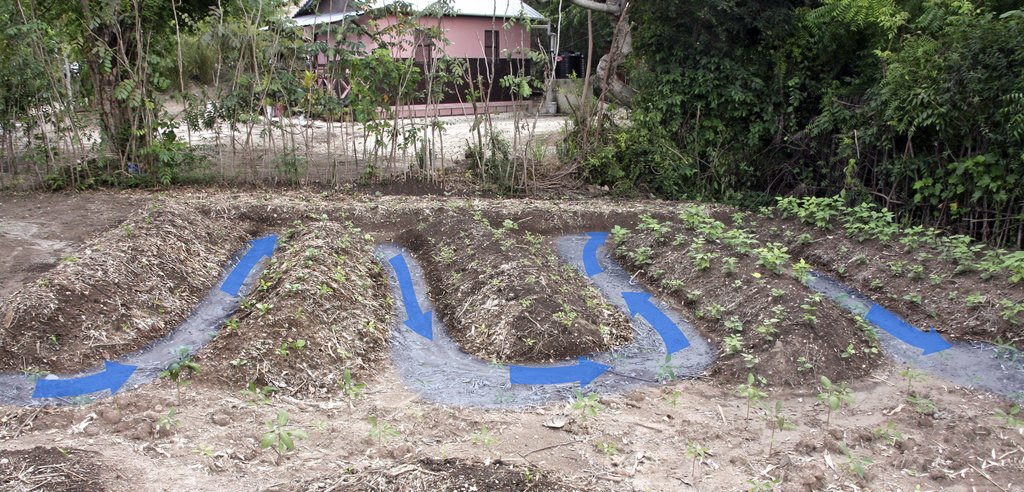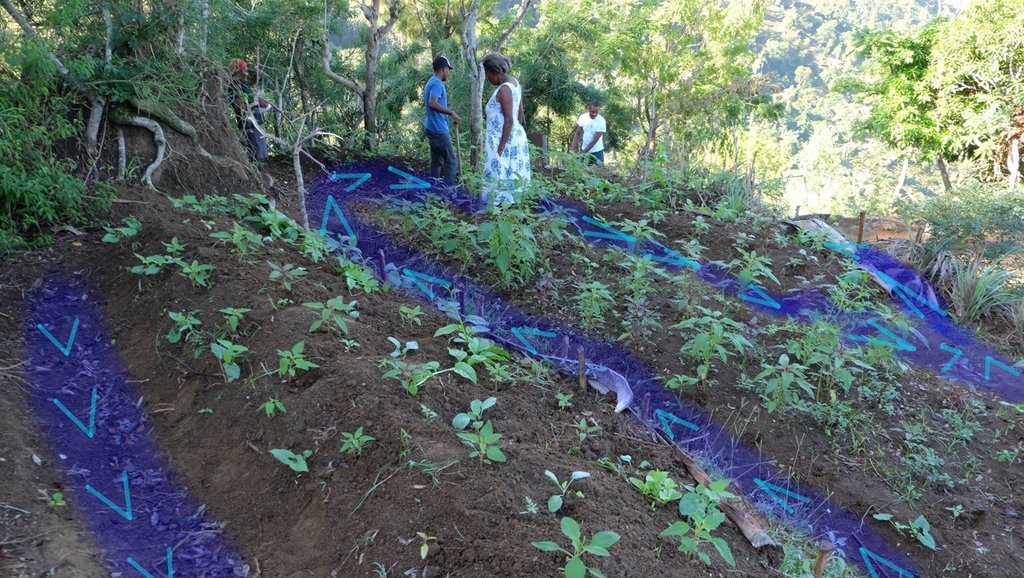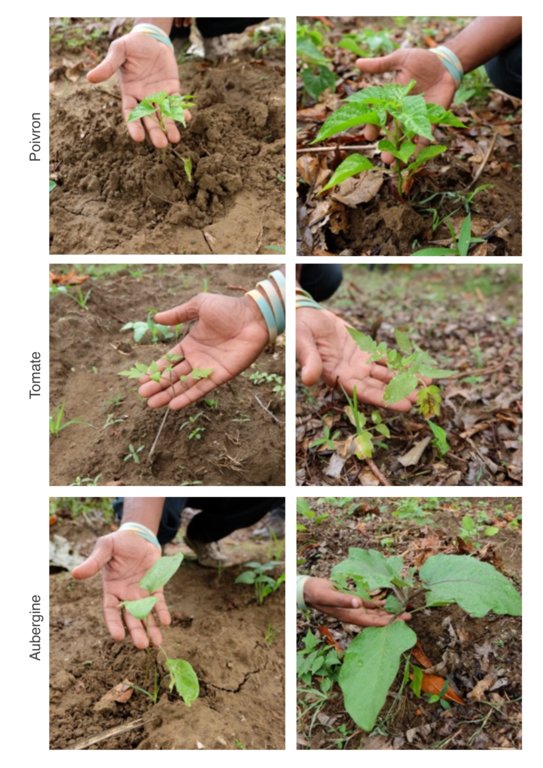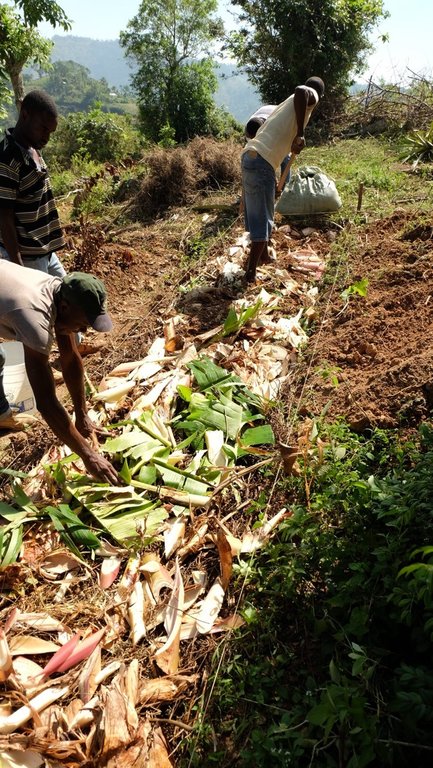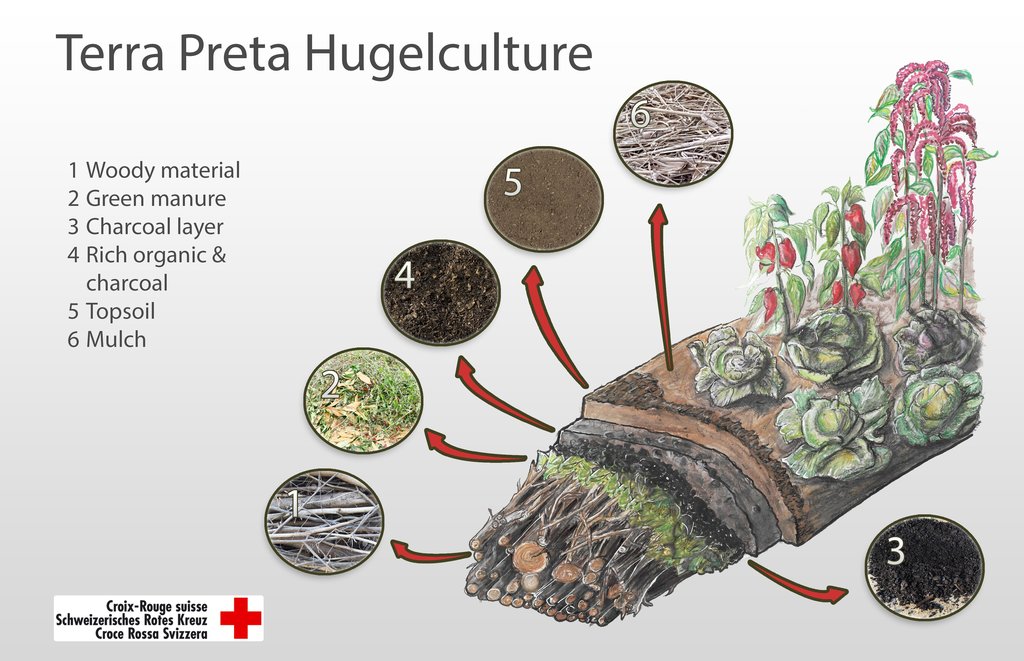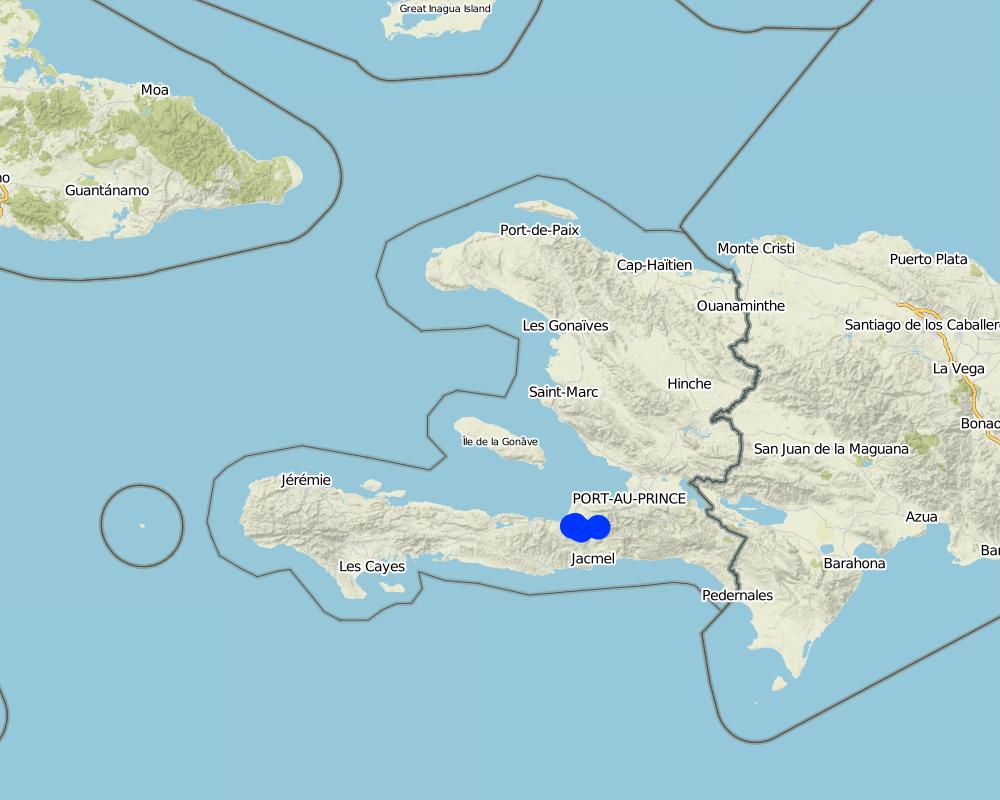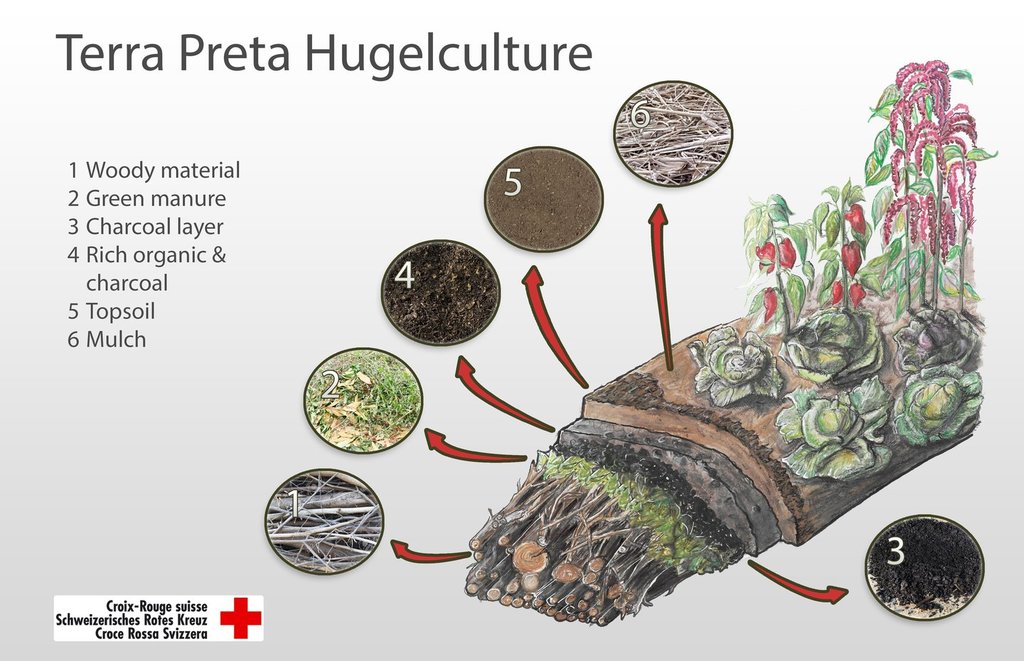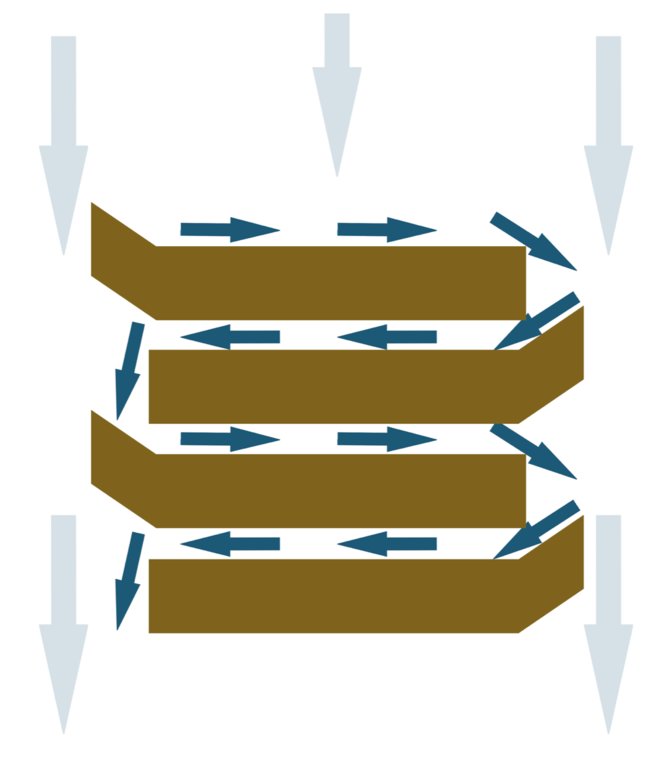Terra Preta raised garden beds [ប្រទេសហៃទី]
- ការបង្កើត៖
- បច្ចុប្បន្នភាព
- អ្នកចងក្រង៖ Karl Harald Bier
- អ្នកកែសម្រួល៖ Anton Jöhr
- អ្នកត្រួតពិនិត្យច្រើនទៀត៖ Alexandra Gavilano, David Beritault
Jaden kolin, Tè mirak
technologies_935 - ប្រទេសហៃទី
ពិនិត្យមើលគ្រប់ផ្នែក
ពង្រីកមើលទាំងអស់ បង្រួមទាំងអស់1. ព័ត៌មានទូទៅ
1.2 ព័ត៌មានលម្អិតពីបុគ្គលសំខាន់ៗ និងស្ថាប័នដែលចូលរួមក្នុងការវាយតម្លៃ និងចងក្រងឯកសារនៃបច្ចេកទេស
ឈ្មោះគម្រោងដែលបានចងក្រងឯកសារ/ វាយតម្លៃលើបច្ចេកទេស (បើទាក់ទង)
Book project: where people and their land are safer - A Compendium of Good Practices in Disaster Risk Reduction (DRR) (where people and their land are safer)ឈ្មោះអង្គភាពមួយ (ច្រើន) ដែលបានចងក្រងឯកសារ/ វាយតម្លៃបច្ចេកទេស (បើទាក់ទង)
Swiss Red Cross (Swiss Red Cross) - ប្រទេសស្វ៊ីស1.3 លក្ខខណ្ឌទាក់ទងទៅនឹងការប្រើប្រាស់ទិន្នន័យដែលបានចងក្រងតាមរយៈ វ៉ូខេត
តើពេលណាដែលទិន្នន័យបានចងក្រង (នៅទីវាល)?
08/12/2016
អ្នកចងក្រង និង(បុគ្គលសំខាន់ៗ)យល់ព្រមទទួលយកនូវលក្ខខណ្ឌនានាទាក់ទងទៅនឹងការប្រើប្រាស់ទិន្នន័យដែលបានចងក្រងតាមរយៈវ៉ូខេត:
បាទ/ចា៎
1.4 សេចក្តីប្រកាសស្តីពីចីរភាពនៃការពណ៌នាពីបច្ចេកទេស
តើបច្ចេកទេសដែលបានពណ៌នានេះមានបញ្ហាដែលផ្តោតលើការធ្លាក់ចុះគុណភាពដី, បើដូច្នេះវាមិនអាចត្រូវបានប្រកាសថាជាបច្ចេកទេសនៃការគ្រប់គ្រងប្រកបដោយចីរភាពទេ?
ទេ
1.5 ការយោងទៅលើកម្រងបញ្ជីសំណួរនៃវិធីសាស្ត្រផ្សព្វផ្សាយ SLM
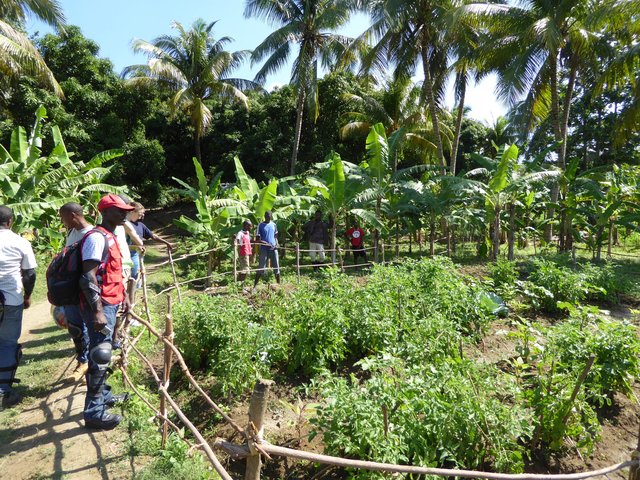
Approche au niveau ménage pour jardins Terra Preta [ប្រទេសហៃទី]
L'approche des jardins Terra Preta au niveau ménage, avec des jardins de démonstration crée avec des membres des Organisations Communautaires de Base (OCB), facilite la vulgarisation de la technologie Terra Preta parmi la population vulnérable des zones rurales de la commune de Léogâne, Haïti.
- អ្នកចងក្រង៖ Helen Gambon
2. ការពណ៌នាពីបច្ចេកទេស SLM
2.1 ការពណ៌នាដោយសង្ខេបពីបច្ចេកទេស
និយមន័យបច្ចេកទេស:
Terra Preta raised garden beds are a combination of techniques from permaculture and the production of Terra Preta, an anthrosol. These garden beds, which were created with local resources, are highly fertile and enable the production of much higher yields than traditional techniques, while diminishing soil erosion.
2.2 ការពណ៌នាលម្អិតពីបច្ចេកទេស
ការពណ៌នា:
One of the major problems in the mountainous rural zones of the municipality of Léogâne in Haiti is the severe degradation and erosion of soils. The soil loss aggravates the vulnerable situation of the local population, mainly farmers. The Terra Preta raised garden beds were introduced in this region after the earthquake of 2010, and were replicated by several organisations and also by members of the communities. They are based on two main techniques:
1) Terra Preta is a technique to create soils based on a lacto-acidic fermentation of organic matter with charcoal powder. This technique was used by indigenous people in Amazonia, and rediscovered and replicated recently by scientists. The technique is characterised by the use of local resources and a high fertility. With this technique, a soil layer of several decimeters can be produced in a few years, whereas this takes normally around 100 years per centimeter. Soil analyses show that the formation of humic acids can be demonstrated after 4 months.
2) Raised garden beds (Hugelculture) are a technique from permaculture. Permaculture is a science of agricultural and social systems which uses the principles of ecology and the knowledge of traditional societies to simulate the diversity, stability and the resilience of natural ecosystems. Raised garden beds consist of an interior of ligneous material, covered by a layer of earth. The elevated construction facilitates the work in the garden and the decomposition of wood inside the beds. Due to their spongy structure, the raised garden beds function as a water reservoir during dry periods.
The garden beds are placed perpendicularly to the slope direction as much as possible, and are arranged alternately, with an extension to redirect the surface runoff towards the structures. This arrangement prevents the water from draining directly. This promotes the infiltration of water into the soil, where it is captured by the ligneous material, which prevents erosion (see the photograph).
The following inputs to the garden beds can be found locally:
- Organic matter: ligneous material, dry straw, fresh straw, harvest residues, organic residues rich in NPK (kitchen waste, animal waste, etc.),
- Charcoal powder (biochar),
- Possibly ashes or other fertile materials.
With these materials, which are generally without cost and locally available, a raised garden bed can be set up in less than an hour. Even without additional fertilisation after the set up, the technique offers the possibility to have several cycles of vegetable production. Experiments showed good results during 4 years of continuous plantation in Thozin (Grand Goâve). In order to secure soil fertility for many years, organic matter can be added after the period of plantation. It can be easily incorporated below the first layer of soil, and the decomposition takes place automatically. When put in place on sloping terrain, the garden beds slow down erosion strongly, and can serve to protect houses.
The technique is valued because of its cost-effectiveness and its sustainability compared to known techniques. The complexity of the implementation can be a limiting factor for an autonomous replication by the beneficiaries. That is when they see the set-up of the structures and think they know how to replicate it without taking account of all the details which are essential for the good functioning of the structures. This is why generally a certain level of support by technicians is required.
2.3 រូបភាពនៃបច្ចេកទេស
2.5 ប្រទេស/តំបន់/ទីតាំងកន្លែង ដែលបច្ចេកទេសត្រូវបានអនុវត្ត និងបានគ្រប់ដណ្តប់ដោយការវាយតម្លៃនេះ
ប្រទេស:
ប្រទេសហៃទី
តំបន់/រដ្ឋ/ខេត្ត:
West department
បញ្ជាក់បន្ថែមពីលក្ខណៈនៃទីតាំង:
Municipality of Léogâne
Map
×2.6 កាលបរិច្ឆេទនៃការអនុវត្ត
ប្រសិនបើមិនច្បាស់ឆ្នាំ សូមបញ្ជាក់កាលបរិច្ឆេទដែលប្រហាក់ប្រហែល:
- តិចជាង 10ឆ្នាំមុន (ថ្មី)
2.7 ការណែនាំពីបច្ចេកទេស
សូមបញ្ជាក់តើបច្ចេកទេសត្រូវបានណែនាំឱ្យអនុវត្តដោយរបៀបណា:
- តាមរយៈគម្រោង / អន្តរាគមន៍ពីខាងក្រៅ
3. ចំណាត់ថ្នាក់នៃបច្ចេកទេស SLM
3.1 គោលបំណងចម្បង (១ ឬច្រើន) នៃបច្ចេកទេសនេះ
- ធ្វើឱ្យប្រសើរឡើងនូវផលិតកម្ម
- កាត់បន្ថយ, បង្ការ, ស្តារឡើងវិញនូវការធ្លាក់ចុះគុណភាពដី
- កាត់បន្ថយហានិភ័យនៃគ្រោះមហន្តរាយ
- កាត់បន្ថយការប្រែប្រួលអាកាសធាតុ និងផលប៉ះពាល់របស់វា
- បង្កើតផលប្រយោជន៍សេដ្ឋកិច្ច
- បង្កើតផលប្រយោជន៍សង្គម
3.2 ប្រភេទដីប្រើប្រាស់មួយប្រភេទ (ច្រើនប្រភេទ) ដែលបានអនុវត្តបច្ចេកទេស

ដីដាំដំណាំ
- ដំណាំប្រចាំឆ្នាំ
ដំណាំចម្បង (ដំណាំកសិ-ឧស្សាហកម្ម និងដំណាំស្បៀង) :
Vegetables (for example pepper, cabbage, spinach, tomato, chili pepper)
មតិយោបល់:
With this technique, marginal land can be cultivated. The soil in place does not play a very important role because the nutrients are contained in the inputs.
ប្រសិនបើដីមានការប្រែប្រួលបន្ទាប់ពីការអនុវត្តបច្ចេកទេស សូមបញ្ជាក់ពីការប្រើប្រាស់ដីមុនពេលអនុវត្តន៍បច្ចេកទេស:
The technology enables the production of vegetables on land that was not productive before (degraded soils, sandy or inert substrates). This allows farmers to diversify their traditional crops of maize, peas, sorghum and sweet potato with vegetables.
3.3 ព័ត៌មានបន្ថែមអំពីអ្នកប្រើប្រាស់ដី
ការផ្គត់ផ្គង់ទឹកនៅកន្លែងអនុវត្តបច្ចេកទេស:
- ទឹកភ្លៀង
ចំនួនសារដែលដាំដំណាំក្នុងមួយឆ្នាំ:
- 2
សូមបញ្ជាក់:
The intervention zone has 2 cropping periods based on 2 rainy seasons. The Terra Preta raised garden beds are usually used all year round.
3.4 ក្រុម SLM ដែលបច្ចេកទេសស្ថិតនៅក្នុង
- ការគ្រប់គ្រងជីជាតិដីតាមបែបចម្រុះ
- វិធានការអនុវត្តកាត់ទទឹងទីជម្រាល
- គេហសួន
3.5 ការសាយភាយនៃបច្ចេកទេស
បញ្ជាក់ពីការសាយភាយនៃបច្ចេកទេស:
- អនុវត្តនៅកន្លែងជាក់លាក់មួយ/ ប្រមូលផ្តុំនៅតំបន់តូចៗ
3.6 វិធានការ SLM ដែលបញ្ចូលនូវបច្ចេកទេស

វិធានការក្សេត្រសាស្ត្រ
- A2: សារធាតុសរីរាង្គ/ជីជាតិដី
- A3: ការរក្សាស្រទាប់ដីខាងលើ

វិធានការរចនាស័ម្ពន្ធ
- S2: ភ្លឺ ច្រាំង
3.7 កំណត់ប្រភេទនៃការធ្លាក់ចុះគុណភាពដីសំខាន់ៗដែលបច្ចេកទេសនេះបានដោះស្រាយ

ការហូរច្រោះដីដោយសារទឹក
- Wt: ការបាត់ដីស្រទាប់លើដោយការហូរច្រោះ
- Wg: ការកកើតឡើងនូវកំទេចកំទីដីស្រទាប់ក្រោម

ការធ្លាក់ចុះជីវសាស្ត្រនៃដី
- Bl: ការបាត់បង់មីក្រូ និងម៉ាក្រូសរីរាង្គរបស់ដី
3.8 ការពារ កាត់បន្ថយ ឬស្តារឡើងវិញនៃការធ្លាក់ចុះគុណភាពដី
បញ្ជាក់ពីគោលដៅរបស់បច្ចេកទេស ដែលផ្តោតទៅការធ្លាក់ចុះគុណភាពដី:
- ការកាត់បន្ថយការធ្លាក់ចុះគុណភាពដី
- ការជួសជុល/ ស្តារឡើងវិញនៃឱនភាពដីធ្ងន់ធ្ងរ
4. បច្ចេកទេសជាក់លាក់ សកម្មភាពអនុវត្ត ធាតុចូល និងថ្លៃដើម
4.1 គំនូសបច្ចេកទេសនៃបច្ចេកទេសនេះ
4.2 លក្ខណៈពិសេសនៃបច្ចេកទេស/ ពណ៌នាពីគំនូរបច្ចេកទេស
1. Terrain analysis:
The first step in the construction is the terrain analysis: what is the size of the terrain, the relief, the environment (vegetation, buildings, water courses) and which are the resources (water, biochar, vegetation, animals, organic residues) present in place? Specific needs and social aspects, the neighbourhood and land holdings must also be considered.
2. Elaborating a land use plan:
The second step is the elaboration of a land use plan: definition of the position of the garden beds, of the protection measures (against wind, sun and heat), and of the vegetables to grow.
3. Construction of the garden beds:
After the preparatory work, the actual construction of the garden beds begins.
- A trench of approximately 10 cm depth is dug (width of 1-1.20 m, length undefined),
- The ligneous materials (decomposing wood, of larger or smaller volume) are arranged to create a mound. Holes between the materials should be filled-up with earth.
- The organic matter is added in layers in the following order: dry straw, animal waste, pulse crops and organic matter rich in NPK.
- Charcoal powder can be added between the layers of rich organic matter, or even better, mixed with the latter.
- A layer of earth of approximately 10 cm is added as cover.
- During the process of construction, every layer should be watered.
The establishment of multiple garden beds is done as described in figure 2 above. The garden beds are installed in alternation with an extension to redirect the surface runoff towards the structures. The water is forced around the structures, which will facilitate the infiltration of the water and the deposition of sediments. As a result, the water is captured in the garden bed, and erosion is reduced. A more detailed description with illustrations is given below.
4.3 ព័ត៌មានទូទៅដែលពាក់ព័ន្ធនឹងការគណនាធាតុចូល និងថ្លៃដើម
កំណត់របៀបនៃការគណនាថ្លៃដើម និងធាតុចូល:
- ក្នុងឯកតាបច្ចេកទេស
បញ្ជាក់ឯកតា:
isolated structure
បញ្ជាក់ទំហំ ប្រវែង ។ល។ (បើពាក់ព័ន្ធ):
width: 1.10 m; length: 10 m
ផ្សេងៗ/ រូបិយប័ណ្ណជាតិ (បញ្ជាក់):
Haiti Gourde
កំណត់អត្រាប្តូរប្រាក់ពីដុល្លាទៅរូបិយប័ណ្ណតំបន់ (បើទាក់ទង)៖ 1 ដុល្លារ =:
68,0
កំណត់ថ្លៃឈ្នួលជាមធ្យមនៃការជួលកម្លាំងពលកម្មក្នុងមួយថ្ងៃ:
250
4.4 សកម្មភាពបង្កើត
| សកម្មភាព | ប្រភេទវិធានការ | ពេលវេលា | |
|---|---|---|---|
| 1. | Outlining of raised garden beds | ផ្សេងៗ | year-round |
| 2. | Collection of materials | ផ្សេងៗ | year-round |
| 3. | Digging a basin along the contour | រចនាសម្ព័ន្ធ | year-round, preferably at the start of the rainy season |
| 4. | Building the different layers (wood, dry straw, fresh straw, pulse crops and organic matter rich in NPK, earth, charcoal powder) | រចនាសម្ព័ន្ធ | year-round, preferably at the start of the rainy season |
| 5. | Replanting of vegetable seedlings | ក្សេត្រសាស្ត្រ | year-round, preferably at the start of the rainy season |
| 6. | Watering | ក្សេត្រសាស្ត្រ | year-round, preferably at the start of the rainy season |
4.5 ថ្លៃដើម និងធាតុចូលដែលត្រូវការសម្រាប់ការបង្កើតបច្ចេកទេស
| បញ្ជាក់ពីធាតុចូល | ឯកតា | បរិមាណ | ថ្លៃដើមក្នុងមួយឯកតា | ថ្លៃធាតុចូលសរុប | % នៃថ្លៃដើមដែលចំណាយដោយអ្នកប្រើប្រាស់ដី | |
|---|---|---|---|---|---|---|
| កម្លាំងពលកម្ម | Skilled labour (technical support) | person-days | 0,5 | 3000,0 | 1500,0 | |
| កម្លាំងពលកម្ម | Unskilled labour (construction) | person-days | 1,0 | 250,0 | 250,0 | 100,0 |
| សម្ភារៈ | Tools (spade, pickaxe) | piece | 1,0 | 5,0 | 5,0 | 100,0 |
| សម្ភារៈដាំដុះ | Seedlings of cabbage | seedling | 10,0 | 10,0 | 100,0 | |
| សម្ភារៈដាំដុះ | Seedlings of spinach | seedling | 20,0 | 5,0 | 100,0 | |
| សម្ភារៈដាំដុះ | Seedlings of tomato | seedling | 10,0 | 5,0 | 50,0 | |
| សម្ភារៈសាងសង់ | Decomposing wood | batch | 1,0 | 200,0 | 200,0 | 100,0 |
| សម្ភារៈសាងសង់ | Earth | batch | 1,0 | 50,0 | 50,0 | 100,0 |
| សម្ភារៈសាងសង់ | Dry straw | batch | 1,0 | 100,0 | 100,0 | 100,0 |
| សម្ភារៈសាងសង់ | Fresh straw | batch | 1,0 | 100,0 | 100,0 | 100,0 |
| សម្ភារៈសាងសង់ | Animal waste | Bag | 1,0 | 100,0 | 100,0 | 100,0 |
| សម្ភារៈសាងសង់ | Charcoal/biochar | kg | 50,0 | 2,0 | 100,0 | 100,0 |
| ថ្លៃដើមសរុបក្នុងការបង្កើតបច្ចេកទេស | 2655,0 | |||||
ប្រសិនបើអ្នកប្រើប្រាស់ដីមិនមានថ្លៃដើម 100% សូមបញ្ជាក់ថានរណាដែលចំណាយថ្លៃដើមដែលនៅសល់:
Swiss Red Cross
មតិយោបល់:
The land users have the necessary tools (5 HTG are budgeted to compensate for the use of their own tools). The construction materials are also locally available, and are generally considered as waste.
4.6 សកម្មភាពថែទាំ
| សកម្មភាព | ប្រភេទវិធានការ | ពេលវេលា/ ភាពញឹកញាប់ | |
|---|---|---|---|
| 1. | watering | ក្សេត្រសាស្ត្រ | 3 days |
| 2. | weeding | ក្សេត្រសាស្ត្រ | 2 weeks |
| 3. | mulching | ក្សេត្រសាស្ត្រ | 2 months |
| 4. | refertilisation | ក្សេត្រសាស្ត្រ | 5 years |
4.7 កំណត់ថ្លៃដើមសម្រាប់ការថែទាំ/ សកម្មភាពរបស់បច្ចេកទេស (ក្នុងរយៈពេលមួយឆ្នាំ)
| បញ្ជាក់ពីធាតុចូល | ឯកតា | បរិមាណ | ថ្លៃដើមក្នុងមួយឯកតា | ថ្លៃធាតុចូលសរុប | % នៃថ្លៃដើមដែលចំណាយដោយអ្នកប្រើប្រាស់ដី | |
|---|---|---|---|---|---|---|
| កម្លាំងពលកម្ម | Annual maintenance | person-days | 15,0 | 250,0 | 3750,0 | 100,0 |
| សម្ភារៈ | Watering device | piece | 1,0 | 150,0 | 150,0 | 100,0 |
| សម្ភារៈដាំដុះ | Seed and seedlings | various | 1,0 | 250,0 | 250,0 | 100,0 |
| ថ្លៃដើមសរុបសម្រាប់ការថែទាំដំណាំតាមបច្ចេកទេស | 4150,0 | |||||
មតិយោបល់:
The indicated costs for the seed and the seedlings are the costs on the local market, but the land users reproduce these from existing plants, that they received from the project for the first implemented raised bed.
4.8 កត្តាសំខាន់បំផុតដែលមានឥទ្ធិពលដល់ការចំណាយ
ពណ៌នាពីកត្តាប៉ះពាល់ចម្បងៗទៅលើថ្លៃដើម:
The labour (and the technical support for the first 3-4 structures of raised beds).
5. លក្ខណៈបរិស្ថានធម្មជាតិ និងមនុស្ស
5.1 អាកាសធាតុ
បរិមាណទឹកភ្លៀងប្រចាំឆ្នាំ
- < 250 មម
- 251-500 មម
- 501-750 មម
- 751-1,000 មម
- 1,001-1,500 មម
- 1,501-2,000 មម
- 2,001-3,000 មម
- 3,001-4,000 មម
- > 4,000 មម
លក្ខណៈពិសេស/ មតិយោបល់លើរដូវភ្លៀង:
There is a dry season from December to February and a rainy season from April to October, with two peaks at the start and at the end of the period, and a relative pause in July.
តំបន់កសិអាកាសធាតុ
- មានភ្លៀងមធ្យម
5.2 សណ្ឋានដី
ជម្រាលជាមធ្យម:
- រាបស្មើ (0-2%)
- ជម្រាលតិចតួច (3-5%)
- មធ្យម (6-10%)
- ជម្រាលខ្ពស់បន្តិច (11-15%)
- ទីទួល (16-30%)
- ទីទួលចោត (31-60%)
- ទីទួលចោតខ្លាំង (>60%)
ទម្រង់ដី:
- ខ្ពង់រាប
- កំពូលភ្នំ
- ជម្រាលភ្នំ
- ជម្រាលទួល
- ជម្រាលជើងភ្នំ
- បាតជ្រលងភ្នំ
តំបន់តាមរយៈកម្ពស់ :
- 0-100 ម
- 101-500 ម
- 501-1,000 ម
- 1,001-1,500 ម
- 1,501-2,000 ម
- 2,001-2,500 ម
- 2,501-3,000 ម
- 3,001-4,000 ម
- > 4,000 ម
បញ្ជាក់ថាតើបច្ចេកទេសនេះត្រូវបានអនុវត្តន៍នៅក្នុង:
- មិនពាក់ព័ន្ធទាំងអស់
5.3 ដី
ជម្រៅដីជាមធ្យម:
- រាក់ខ្លាំង (0-20 សម)
- រាក់ (21-50 សម)
- មធ្យម (51-80 សម)
- ជ្រៅ (81-120 សម)
- ជ្រៅខ្លាំង (> 120 សម)
វាយនភាពដី (ស្រទាប់លើ):
- មធ្យម (ល្បាយ, ល្បាប់)
- ម៉ត់/ ធ្ងន់ (ឥដ្ឋ)
វាយនភាពដី (> 20 សម ស្រទាប់ក្នុង):
- គ្រើម/ មានពន្លឺ (ខ្សាច់)
សារធាតុសរីរាង្គនៅស្រទាប់ដីខាងលើ:
- ទាប (<1%)
5.4 ទឹកដែលអាចទាញមកប្រើប្រាស់បាន និងគុណភាពទឹក
នីវ៉ូទឹកក្រោមដី:
> 50 ម
ទឹកលើដីដែលអាចទាញយកប្រើប្រាស់បាន:
កម្រិតមធ្យម
គុណភាពទឹក (មិនបានធ្វើប្រត្តិកម្ម):
ទឹកពិសារដែលគ្មានគុណភាព (តម្រូវឱ្យមានការសំអាត)
តើមានបញ្ហាភាពទឹកប្រៃហូរចូលមកដែរឬទេ?
ទេ
តើទឹកជំនន់កំពុងកើតមាននៅតំបន់នេះដែររឺទេ?
ទេ
5.5 ជីវៈចម្រុះ
ភាពសម្បូរបែបនៃប្រភេទ:
- កម្រិតមធ្យម
ភាពសម្បូរបែបនៃទីជម្រក:
- ទាប
5.6 លក្ខណៈនៃអ្នកប្រើប្រាស់ដីដែលអនុវត្តបច្ចេកទេស
នៅមួយកន្លែង ឬពនេចរ :
- នៅមួយកន្លែង
ទីផ្សារនៃប្រព័ន្ធផលិតកម្ម:
- សម្រាប់ហូបក្នុងគ្រួសារ (ផ្គត់ផ្គង់ខ្លួនឯង)
ចំណូលក្រៅកសិកម្ម:
- តិចជាង 10% នៃចំណូល
កម្រិតជីវភាព:
- មិនល្អខ្លាំង
ឯកជន ឬក្រុម:
- ធ្វើខ្លួនឯង/ គ្រួសារ
កម្រិតប្រើប្រាស់គ្រឿងយន្ត:
- ប្រើកម្លាំងពលកម្ម
យេនឌ័រ:
- ស្ត្រី
- បុរស
អាយុរបស់អ្នកប្រើប្រាស់ដី:
- វ័យកណ្តាល
- មនុស្សចាស់
5.7 ទំហំផ្ទៃដីជាមធ្យមនៃដីផ្ទាល់ខ្លួន ឬជួលគេដែលបានអនុវត្តបច្ចេកទេស
- < 0.5 ហិកតា
- 0.5-1 ហិកតា
- 1-2 ហិកតា
- 2-5 ហិកតា
- 5-15 ហិកតា
- 15-50 ហិកតា
- 50-100 ហិកតា
- 100-500 ហិកតា
- 500-1,000 ហិកតា
- 1,000-10,000 ហិកតា
- > 10,000 ហិកតា
តើផ្ទៃដីនេះចាត់ទុកជាទំហំកម្រិតណាដែរ ខ្នាតតូច មធ្យម ឬខ្នាតធំ (ធៀបនឹងបរិបទតំបន់)?
- ខ្នាតតូច
5.8 ភាពជាម្ចាស់ដី កម្មសិទ្ធប្រើប្រាស់ដី និងកម្មសិទ្ធប្រើប្រាស់ទឹក
ភាពជាម្ចាស់ដី:
- ឯកជន មិនមានកម្មសិទ្ធ
- ឯកជន មានកម្មសិទ្ធ
កម្មសិទ្ធិប្រើប្រាស់ដី:
- ឯកជន
កម្មសិទ្ធប្រើប្រាស់ទឹក:
- អាស្រ័យផលសេរី (មិនមានការកំណត់)
- ឯកជន
5.9 ការប្រើប្រាស់សេវាកម្ម និងហេដ្ឋារចនាសម្ព័ន្ធ
សុខភាព:
- មិនល្អ
- មធ្យម
- ល្អ
ការអប់រំ:
- មិនល្អ
- មធ្យម
- ល្អ
ជំនួយបច្ចេកទេស:
- មិនល្អ
- មធ្យម
- ល្អ
ការងារ (ឧ. ការងារក្រៅកសិដ្ឋាន):
- មិនល្អ
- មធ្យម
- ល្អ
ទីផ្សារ:
- មិនល្អ
- មធ្យម
- ល្អ
ថាមពល:
- មិនល្អ
- មធ្យម
- ល្អ
ផ្លូវ និងការដឹកជញ្ជូន:
- មិនល្អ
- មធ្យម
- ល្អ
ទឹកផឹក និងអនាម័យ:
- មិនល្អ
- មធ្យម
- ល្អ
សេវាកម្មហិរញ្ញវត្ថុ:
- មិនល្អ
- មធ្យម
- ល្អ
6. ផលប៉ះពាល់ និងការសន្និដ្ឋាន
6.1 ផលប៉ះពាល់ក្នុងបរិវេណអនុវត្តបច្ចេកទេសដែលកើតមាន
ផលប៉ះពាល់លើសេដ្ឋកិច្ចសង្គម
ផលិតផល
ផលិតកម្មដំណាំ
គុណភាពក្រោយ SLM:
an increase of yields by 2-3 times
មតិយោបល់/ ការបញ្ជាក់:
The yield usually increases 2-3 times with the introduction of the technique.
គុណភាពដំណាំ
មតិយោបល់/ ការបញ្ជាក់:
The crops are more healthy and more resistant to diseases. The quality of the vegetables is better, and clients on the market of Grand Goâve pay more for the products from Terra Preta.
ភាពសម្បូរបែបនៃផលិតផល
មតិយោបល់/ ការបញ្ជាក់:
The majority of persons in the area are not used to vegetable growing. The technique makes it possible to grow vegetables which increase the nutritional basis (rice, pearl millet, sweet potato and peas).
ផ្ទៃដីផលិតកម្ម
មតិយោបល់/ ការបញ្ជាក់:
Normally, the soils are not used for crop production. Through the technique production area is created. In addition, the surface increases through the undulated shape of the garden beds.
ផលប៉ះពាល់ទៅលើអេកូឡូស៊ី
វដ្តទឹក/លំហូរ
បរិមាណទឹក
មតិយោបល់/ ការបញ្ជាក់:
a) The infiltration of water in the soil is facilitated.
b) The water is retained by the organic matter in the garden beds (especially by the decomposing wood).
លំហូរទឹកលើផ្ទៃដី
ដី
សំណើមដី
ការកើនឡើងដី
មតិយោបល់/ ការបញ្ជាក់:
Water erosion is slowed down by the garden beds, and the sediments are deposited in front of these. However, the size of the garden beds is limited, and in order to combat erosion on a larger scale additional measures must be considered, like vegetated barriers or terracing.
ដីហាប់
សារធាតុសរីរាង្គដី/ការបូនក្រោមដី
មតិយោបល់/ ការបញ្ជាក់:
Soil analyses
sample 1: 0.93%- >3.50%
sample 2: 2.04% - >5.51%
ការកាត់បន្ថយហានិភ័យនៃគ្រោះមហន្តរាយ និងគ្រោះអាកាសធាតុ
ផលប៉ះពាល់នៃគ្រោះរាំងស្ងួត
មតិយោបល់/ ការបញ្ជាក់:
In the dry periods, the technique permits to continue crop production during several weeks without irrigation.
ការបំភាយនៃកាបូន និងឧស្ម័នផ្ទះកញ្ចក់
មតិយោបល់/ ការបញ្ជាក់:
Sequestered in the soil by the charcoal and the organic matter (especially the ligneous material).
6.2 ផលប៉ះពាល់ក្រៅបរិវេណអនុវត្តបច្ចេកទេសដែលកើតមាន
ទឹកដែលអាចទាញមកប្រើប្រាស់បាន
6.3 ភាពប្រឈម និងភាពរួសនៃបច្ចេកទេសទៅនឹងការប្រែប្រួលអាកាសធាតុ និងគ្រោះអាកាសធាតុ/ គ្រោះមហន្តរាយ (ដែលដឹងដោយអ្នកប្រើប្រាស់ដី)
គ្រោះអាកាសធាតុ (មហន្តរាយ)
គ្រោះមហន្តរាយធម្មជាតិ
| លក្ខណៈឆ្លើយតបនៃបច្ចេកទេសទៅនឹងការប្រែប្រួលអាកាសធាតុ | |
|---|---|
| ព្យុះតំបន់ត្រូពិច | មធ្យម |
| ព្យុះភ្លៀងតាមតំបន់ | ល្អណាស់ |
| ព្យុះរន្ទះតាមតំបន់ | ល្អ |
6.4 ការវិភាគថ្លៃដើម និងអត្ថប្រយោជន៍
តើផលចំណេញ និងថ្លៃដើមត្រូវបានប្រៀបធៀបគ្នាយ៉ាងដូចម្តេច (ទស្សនៈរបស់អ្នកប្រើប្រាស់ដី)?
រយៈពេលខ្លី:
វិជ្ជមានខ្លាំង
រយៈពេលវែង:
វិជ្ជមានខ្លាំង
តើផលចំណេញ និងការថែទាំ/ ជួសជុលត្រូវបានប្រៀបធៀបគ្នាយ៉ាងដូចម្តេច (ទស្សនៈរបស់អ្នកប្រើប្រាស់ដី)?
រយៈពេលខ្លី:
វិជ្ជមានខ្លាំង
រយៈពេលវែង:
វិជ្ជមានខ្លាំង
6.5 ការទទួលយកបច្ចេកទេស
- 1-10%
បើអាច សូមបញ្ជាក់ពីបរិមាណ (ចំនួនគ្រួសារ និង/ ឬតំបន់គ្របដណ្តប់):
>300 households
ក្នុងចំណោមគ្រួសារទាំងអស់ដែលអនុវត្តបច្ចេកទេស តើមានប៉ុន្មានគ្រួសារដែលចង់ធ្វើដោយខ្លួនឯង ដោយមិនទទួលបានសម្ភារៈលើកទឹកចិត្ត/ប្រាក់ឧបត្ថម្ភ?:
- 50-90%
មតិយោបល់:
Small quantities of seed were given.
6.6 ការបន្សុំា
តើថ្មីៗនេះ បច្ចេកទេសនេះត្រូវបានកែតម្រូវដើម្បីបន្ស៊ាំទៅនឹងស្ថានភាពប្រែប្រួលដែរឬទេ?
ទេ
6.7 ភាពខ្លាំង/ គុណសម្បត្តិ/ ឱកាសនៃបច្ចេកទេស
| ភាពខ្លាំង/ គុណសម្បត្តិ/ ឱកាសនៅកន្លែងរបស់អ្នកប្រើប្រាស់ដី |
|---|
|
Strongly increased yield |
| Improved product quality (size, taste) |
| Shortened crop cycle |
| ភាពខ្លាំង/ គុណសម្បត្តិ/ ឱកាស ទស្សនៈរបស់បុគ្គលសំខាន់ៗ |
|---|
| Increased production (several times) |
| Improved nutrition |
| Income generation for the farmers |
| Shortened production cycle |
6.8 ភាពខ្សោយ/ គុណវិបត្តិ/ ហានិភ័យនៃបច្ចេកទេស និងវិធីសាស្ត្រដោះស្រាយ
| ភាពខ្សោយ/ គុណវិបត្តិ/ ហានិភ័យ ទស្សនៈរបស់អ្នកប្រើប្រាស់ដី | តើបច្ចេកទេសទាំងនោះបានដោះស្រាយបញ្ហាដូចម្តេច? |
|---|---|
| More work than traditional techniques. The latter are focused on agricultural production in fields (maize, pearl millet, sweet potato, peas/beans), and require considerably less daily maintenance. | By having the gardens close to the house for follow-up and support. |
| ភាពខ្សោយ/ គុណវិបត្តិ/ ហានិភ័យ ទស្សនៈរបស់អ្នកចងក្រងឬបុគ្គលសំខាន់ៗ | តើបច្ចេកទេសទាំងនោះបានដោះស្រាយបញ្ហាដូចម្តេច? |
|---|---|
| Complexity of the technique | Regular education, follow-up and continuous support |
7. ឯកសារយោង និងវេបសាយ
7.1 វិធីសាស្ត្រ/ ប្រភពនៃព័ត៌មាន
- តាមការចុះទីវាល ការស្រាវជ្រាវនៅទីវាល
80
- ការសម្ភាសន៍ជាមួយអ្នកប្រើប្រាស់ដី
30
- ការសម្ភាសន៍ជាមួយអ្នកជំនាញ/ ឯកទេស
D. Buchon, external consultant
7.2 ឯកសារយោងដែលបានចេញផ្សាយ
ចំណងជើង អ្នកនិពន្ធ ឆ្នាំ ISBN:
Terra Preta: Production. Guide des méthodes de la production de Terra Preta dans les jardins potagères. Karl Harald Bier. 2013.
មានប្រភពមកពីណា? ថ្លៃដើមប៉ុន្មាន?
Welthungerhilfe
ចំណងជើង អ្នកនិពន្ធ ឆ្នាំ ISBN:
Pas de la mise en place d'un Jardin Colline TP. Karl Harald Bier. Swiss Red Cross
មានប្រភពមកពីណា? ថ្លៃដើមប៉ុន្មាន?
info@redcross.ch
7.3 ចូលទៅទាញយកឯកសារដែលពាក់ព័ន្ធតាមបណ្តាញអ៊ិនធឺណែត
ចំណងជើង/ ពណ៌នា:
Terra Preta - Charbon bio - Climatefarming, Hans-Peter Schmidt, 2008, ISSN 1663-0521
វេបសាយ:
http://www.ithaka-journal.net/climatefarming-fr1?lang=fr
ការតភ្ជាប់ និងម៉ូឌុល
ពង្រីកមើលទាំងអស់ បង្រួមទាំងអស់ការតភ្ជាប់

Approche au niveau ménage pour jardins Terra Preta [ប្រទេសហៃទី]
L'approche des jardins Terra Preta au niveau ménage, avec des jardins de démonstration crée avec des membres des Organisations Communautaires de Base (OCB), facilite la vulgarisation de la technologie Terra Preta parmi la population vulnérable des zones rurales de la commune de Léogâne, Haïti.
- អ្នកចងក្រង៖ Helen Gambon
ម៉ូឌុល
គ្មានម៉ូឌុល



